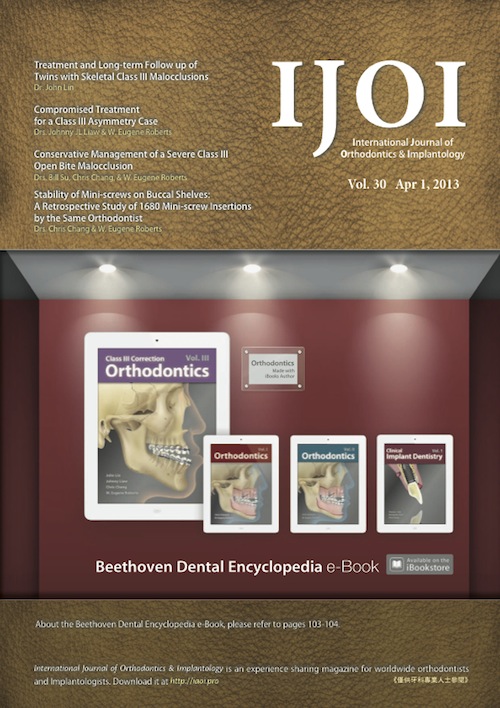IJOI Vol. 30

Treatment and Long-term Follow up of Twins with Skeletal Class III Malocclusions
Lin JJ
Fraternal twins, one male and one female, presented for orthodontic treatment with a chief complaint of complete anterior crossbite extending into the right posterior segments and crowding. (Int J Orthod Implantol 2013;30:4-17)
Compromised Treatment for a Class III Asymmetry Case
Liaw JL, Roberts WE
History and Etiology
An 18 year-old female patient, accompanied by her mother, presented for orthodontic treatment with chief complaints of anterior crossbite and mandibular prognathism. Since the patient did not speak Chinese, all communication was interpreted by her Taiwanese mother for the patient and her Japanese father. The family lived in Japan, but the mother wanted her daughter to receive orthodontic treatment in Taiwan, because they were not satisfied with the opinions of Japanese orthodontists, who felt that orthognathic surgery was the only viable option. (Int J Orthod Implantol 2013;30:22-36)
Conservative Management of a Severe Class III Open Bite Malocclusion
Su B, Chang CH, Roberts WE
History and Etiology
A 17-year-11-month-old girl was referred by her dentist for orthodontic consultation (Fig. 1). Her chief concerns were anterior cross bite, open bite and prognathic mandible (Figs. 2 and 3). She was told that surgery is the best solution for her severe malocclusion. However, the patient deemed that approach to be too aggressive, thus a nonsurgical camouflage plan was devised to meet her needs. There was no contributory medical or dental history. The patient was treated to an acceptable outcome as documented in Figs. 4-9. The details for diagnosis and treatment of this challenging malocclusion will be discussed in the following sections. (Int J Orthod Implantol 2013;30:40-60)
Early Treatment of Anterior Crossbite Complicated by Maxillary Posterior Crowding
Tseng SP, Chang CH, Roberts WE
History and Etiology
An 8-year-1-month female presented with her parents for orthodontic consultation. The chief concerns were anterior crossbite and severe crowding in the maxillary posterior segments. Her facial profile was orthognathic and frontal symmetry was within normal limits (WNL). The mandibular permanent incisors and first molars were present. Maxillary primary lateral incisors, canines and left first molar were retained, but all four upper premolars were erupted in malposed positions (Figs. 1-3). The etiology of the malocclusion was presumed to be a more palatal ectopic path of eruption for maxillary incisors and canines. There was no other contributing medical or dental history. (Int J Orthod Implantol 2013;30:62-75)
Stability of Mini-screws on Buccal Shelves: A Retrospective Study of 1680 Mini-screw Insertions by the Same Orthodontist
Chang CH, Roberts WE
Background: Previous studies on inter-radicular screw insertion have shown that there was a significantly higher failure rate for screws inserted through movable mucosa compared to attached gingiva. Furthermore, there are no reports about the stability of the extra-radicular screw insertion into the buccal shelf of the mandible. This is an important area of research because extra-radicular mini-screws placed in the buccal shelf are effective anchorage, for retracting the entire lower dentition to correct Class III malocclusion. It is important to understand the success rate and stability for buccal shelf miniscrews placed in different locations. (Int J Orthod Implantol 2013;30:76-78)
Surgical and Orthodontic Management of Impacted Mandibular Premolars with a Severely Dilacerated Root
Lee G, Chang CH
Introduction
Impaction with a severely dilacerated root of the mandibular premolar is seldom reported, especially when it is combined with odontoma. This case showed impacted mandibular premolars due to a compound odontoma. Extraction of the primary teeth, excision of the odontoma, and an orthodontic forced eruption were performed to erupt the lower premolars. This article illustrates step by step treatment to achieve a predictable outcome. (Int J Orthod Implantol 2013;30:80-89)